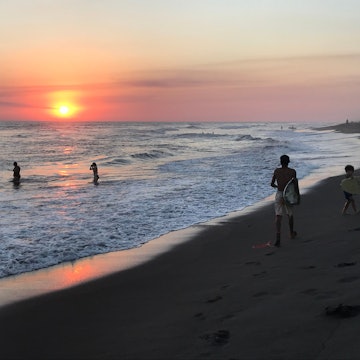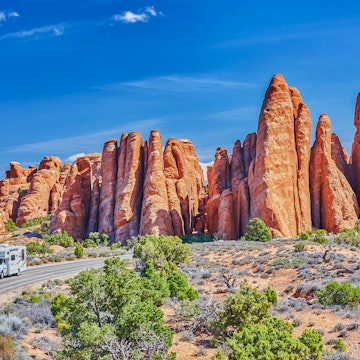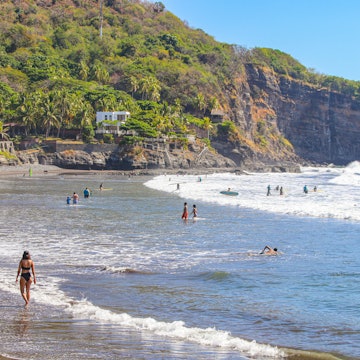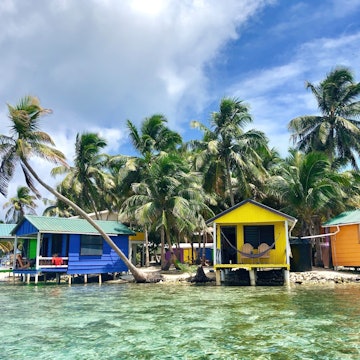
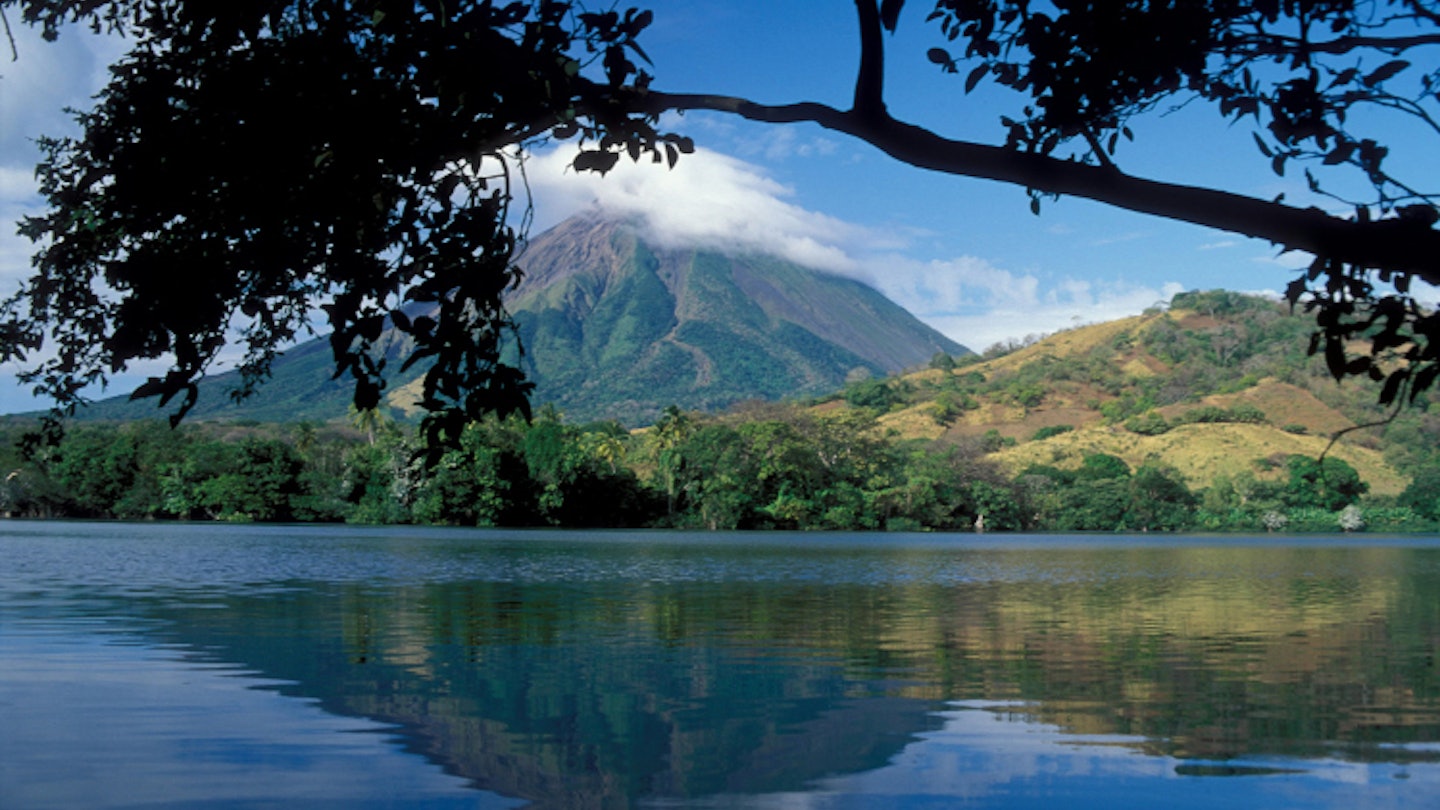
Volcán Concepción, Nicaragua. Image by Chlaus Lotscher Getty
Lago de Nicaragua, Central America's largest lake, is a body of water so enormous that the Spanish conquistadors mistook it for the ocean until they saw their horses drinking from it and christened it La Mar Dulce, or the sweet sea. Its serene waters surround a series of unspoiled volcanic islands, each offering a uniquely tranquil experience for those passing through.
The future of this peaceful landscape lies in limbo, however. In 2013, Chinese businessman Wang Jing signed a controversial deal with the Nicaraguan government to build and manage a waterway three times the length of the Panama Canal. The project was set to generate hundreds of thousands of jobs and turn Nicaragua from one of the poorest countries in the western hemisphere to one of the richest in Central America. The trade-off would be the destruction of a massive swathe of pristine rainforest and wetlands, and the depletion of the country’s primary source of fresh water. Construction was due to begin at the end of 2014, but so far no progress has taken place and any future development is uncertain.
Despite its position at this economic crossroads, Lake Nicaragua and its islands continue to attract visitors, and for good reason – pop in and explore this beautiful freshwater oasis while you can.
Isla de Ometepe
The twin-coned volcanic island of Ometepe, the world’s largest freshwater island, was once home to the Nahuatl people – Ometepe means ‘two hills’ in their language – who fled the Aztecs in Mexico, and you can still find ancient petroglyphs dotted around the island. Today, there are two main settlements on either side of Volcán Concepción: Moyogalpa and the smaller and more alluring Altagracia, as well as several natural reserves, such as Chaco Verde. The island’s friendly inhabitants survive on fishing and farming, planting rice, corn and coffee, among other crops, on the volcanoes fertile slopes. They’re also turning their hand to ecotourism and staying at a family-run guesthouse is the perfect way to experience the island. You can get active, hiking, biking and kayaking. Climb still-grumbling Volcán Concepción, with a steep, perfect cone rising to 1,610m, and the easier and muddier Volcán Maderas, whose slopes are lined with misty jungle and home to vociferous howler monkeys. Then kick back in a hammock or lounge on a lakeshore beach with a local beer or two, and watch the clouds wrap around the volcanoes’ peaks.
Get there: There are several daily boats to Ometepe from San Jorge in Rivas province.

Archipiélago de Solentiname
Of the 36 verdant volcanic islands that make up this isolated archipelago in the south-eastern corner of Lago de Nicaragua, only four are inhabited – San Fernando, Mancarrón, La Venada and Mancarroncita – and all are without roads, electricity and running water. The draw is their beauty and tranquility, and the art – many of the islands’ 900 or so inhabitants combine farming and fishing with painting and woodcarving. Almost 50 years ago, they began to produce art inspired by their daily struggle and the islands’ lush landscape with the help of a politician, poet and priest, Ernesto Cardenal. Visit them in their homes and you’ll find three or more generations living and working together, creating brightly colored balsa-wood animals and paintings. But it hasn’t always been so tranquil; during the revolution that brought the Sandinistas to power in 1979, it was a hotbed of political activity. On Mancarrón, you can visit Cardenal’s cabin and church, with its pre-Colombian style altar and whitewashed walls decorated with the locals’ paintings, as well as a monument dedicated to five young men who died in the uprising. Don’t miss a trip to Refugio de Vida Silvestre Los Guatuzos, a maze of waterways flanked by tropical forest teeming with wildlife, such as sloth and elusive jaguars, as well as almost 400 species of bird. Climb the vertigo-inducing steps to the aerial walkway for a monkey’s-eye view of the forest.
Get there: La Costeña operates a daily flight from Managua to San Carlos, from where you can take a panga, or motorized canoe. There is also a daily fast boat ferry between the islands and San Carlos.

Las Isletas
The 360 or so diminutive islands scattered around the lake about 20 kilometers south of colonial Granada, were created around 20,000 years ago, when Volcán Mombacho spectacularly erupted, spewing boulders, ash and molten lava into the lake. The isletas come in all shapes and sizes, with a small community of fishermen living in ramshackle wooden houses, while an increasing number are being snapped up by wealthy Nicaraguans and foreign investors to house extravagant summer mansions or eco-friendly lodges.

Many are home to nothing more than swaying palm trees and inquisitive capuchin monkeys. On land, you can explore the small, 18th-century Fortin de San Pablo, built by the Spanish conquistadors to protect Granada against marauding buccaneers. You can take a boat tour from Granada but the best way to explore the shallow channels around the isletas is by kayak. As you serenely glide through the calm water, you’ll be able to spy on the resident birds, such as cormorants, herons, parrots, hawks and vultures, as well as locals going about their daily lives, little changed for generations. It will give you a sense of the size of Lago de Nicaragua, along with picture-perfect views of Volcán Mombacho at every turn.
Get there: Boat and kayak tours depart from Puerto Asese and Cabañas Amarillo, both a short taxi ride from central Granada.
This article was refreshed in August 2017.






